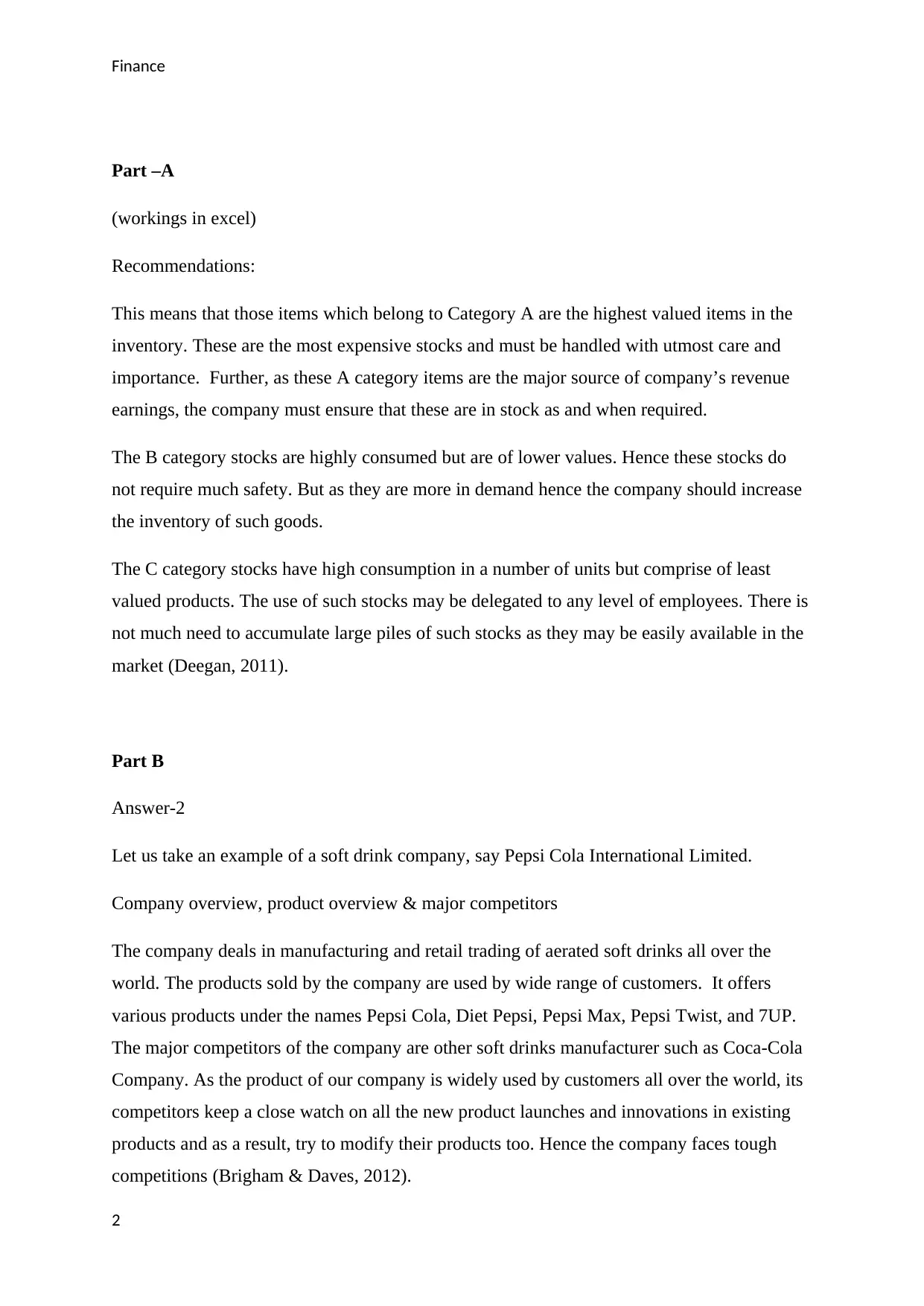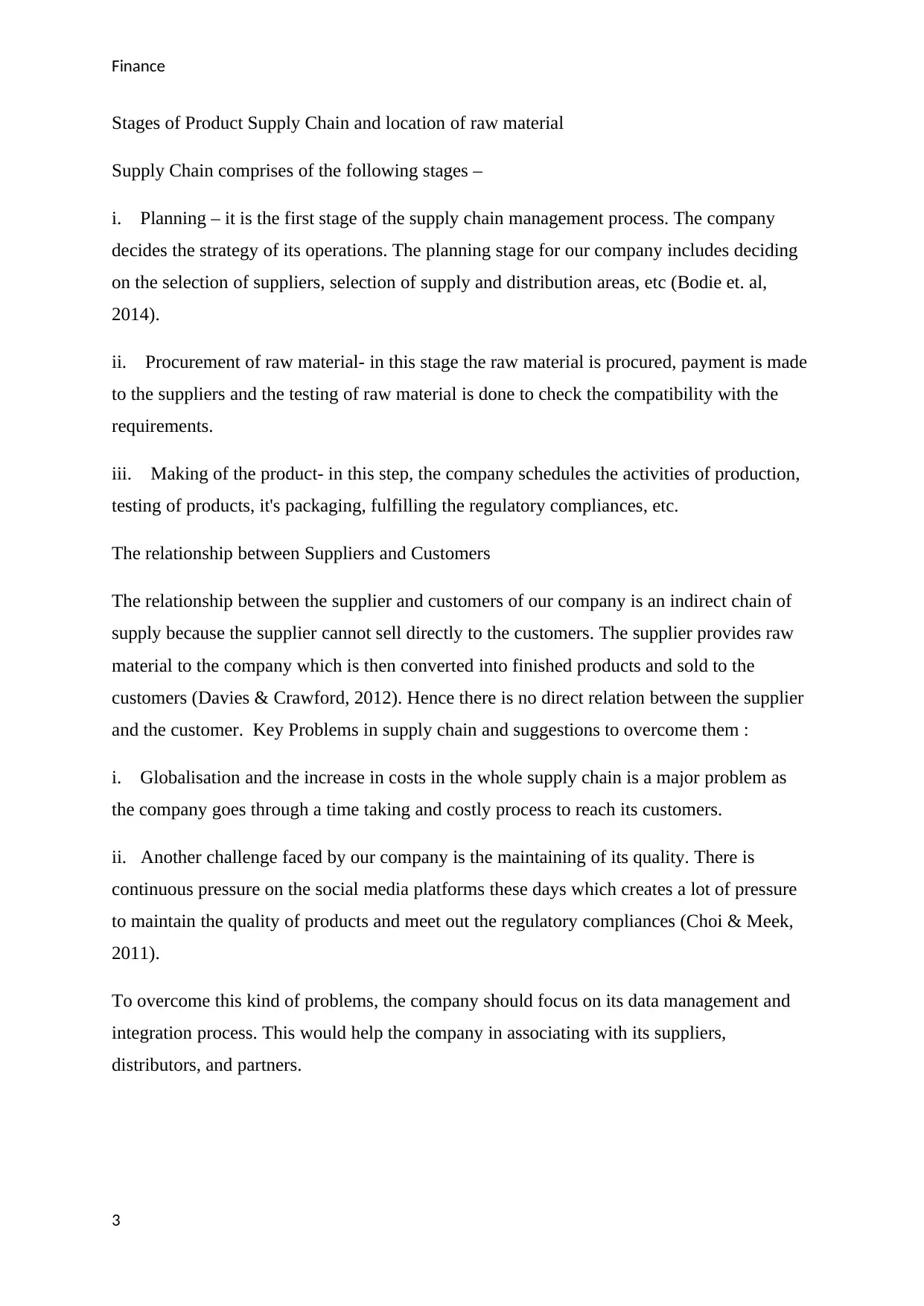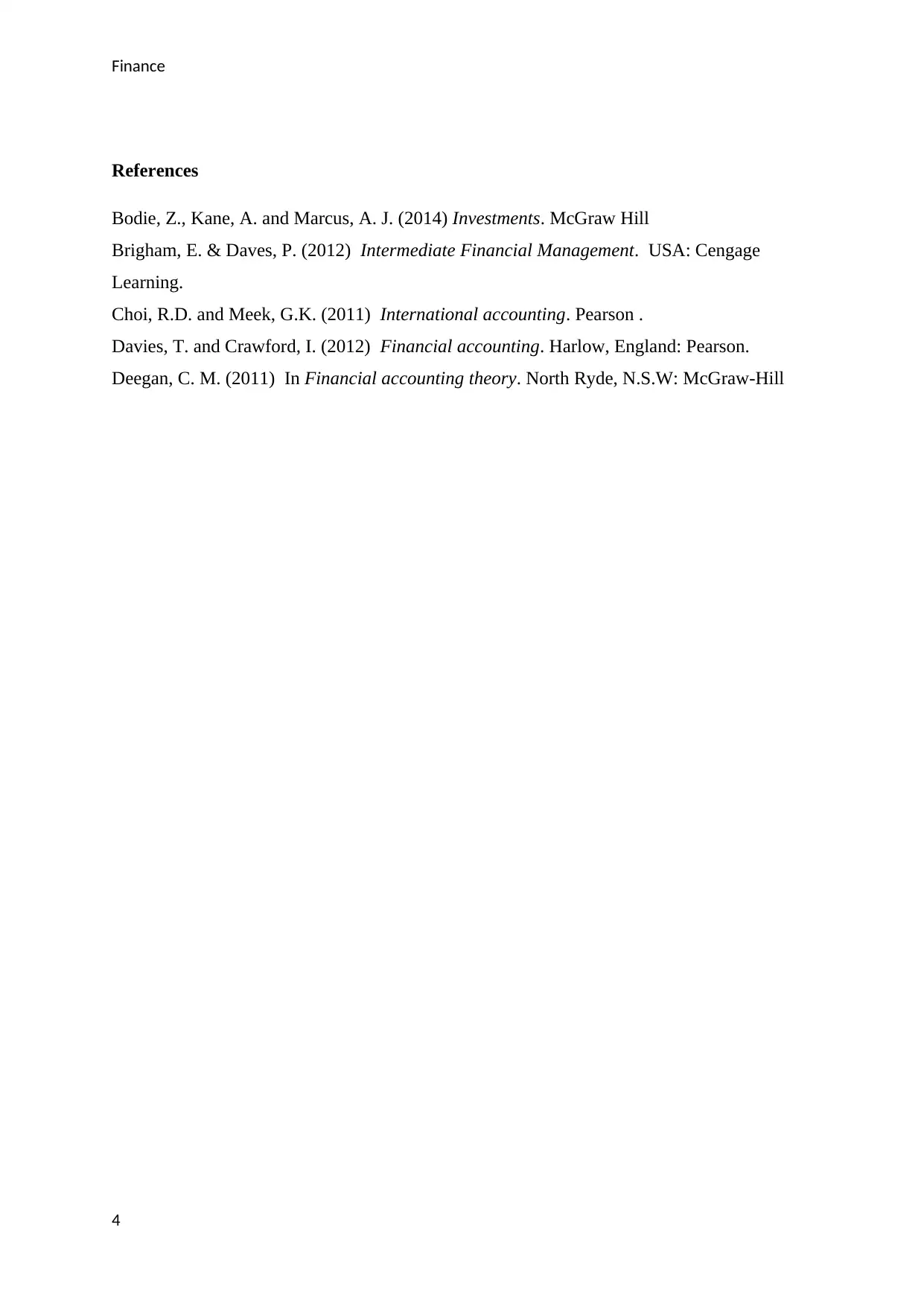Finance Report: Inventory ABC Analysis and Supply Chain Management
VerifiedAdded on 2023/06/12
|4
|798
|450
Report
AI Summary
This finance report covers inventory management using the ABC analysis approach, categorizing items based on their value and usage to optimize stock control. It also delves into supply chain management, using Pepsi Cola International Limited as an example to illustrate stages like planning, raw material procurement, and product manufacturing. The report discusses the relationship between suppliers and customers, key problems in the supply chain such as globalization and quality maintenance, and suggests data management and integration as solutions. It includes recommendations for managing different inventory categories and references relevant academic sources.

qwertyuiopasdfghjklzxcvbnmqwerty
uiopasdfghjklzxcvbnmqwertyuiopasd
fghjklzxcvbnmqwertyuiopasdfghjklzx
cvbnmqwertyuiopasdfghjklzxcvbnmq
wertyuiopasdfghjklzxcvbnmqwertyui
opasdfghjklzxcvbnmqwertyuiopasdfg
hjklzxcvbnmqwertyuiopasdfghjklzxc
vbnmqwertyuiopasdfghjklzxcvbnmq
wertyuiopasdfghjklzxcvbnmqwertyui
opasdfghjklzxcvbnmqwertyuiopasdfg
hjklzxcvbnmqwertyuiopasdfghjklzxc
vbnmqwertyuiopasdfghjklzxcvbnmq
wertyuiopasdfghjklzxcvbnmqwertyui
opasdfghjklzxcvbnmqwertyuiopasdfg
hjklzxcvbnmrtyuiopasdfghjklzxcvbn
mqwertyuiopasdfghjklzxcvbnmqwert
yuiopasdfghjklzxcvbnmqwertyuiopas
B203A
uiopasdfghjklzxcvbnmqwertyuiopasd
fghjklzxcvbnmqwertyuiopasdfghjklzx
cvbnmqwertyuiopasdfghjklzxcvbnmq
wertyuiopasdfghjklzxcvbnmqwertyui
opasdfghjklzxcvbnmqwertyuiopasdfg
hjklzxcvbnmqwertyuiopasdfghjklzxc
vbnmqwertyuiopasdfghjklzxcvbnmq
wertyuiopasdfghjklzxcvbnmqwertyui
opasdfghjklzxcvbnmqwertyuiopasdfg
hjklzxcvbnmqwertyuiopasdfghjklzxc
vbnmqwertyuiopasdfghjklzxcvbnmq
wertyuiopasdfghjklzxcvbnmqwertyui
opasdfghjklzxcvbnmqwertyuiopasdfg
hjklzxcvbnmrtyuiopasdfghjklzxcvbn
mqwertyuiopasdfghjklzxcvbnmqwert
yuiopasdfghjklzxcvbnmqwertyuiopas
B203A
Paraphrase This Document
Need a fresh take? Get an instant paraphrase of this document with our AI Paraphraser

Finance
Part –A
(workings in excel)
Recommendations:
This means that those items which belong to Category A are the highest valued items in the
inventory. These are the most expensive stocks and must be handled with utmost care and
importance. Further, as these A category items are the major source of company’s revenue
earnings, the company must ensure that these are in stock as and when required.
The B category stocks are highly consumed but are of lower values. Hence these stocks do
not require much safety. But as they are more in demand hence the company should increase
the inventory of such goods.
The C category stocks have high consumption in a number of units but comprise of least
valued products. The use of such stocks may be delegated to any level of employees. There is
not much need to accumulate large piles of such stocks as they may be easily available in the
market (Deegan, 2011).
Part B
Answer-2
Let us take an example of a soft drink company, say Pepsi Cola International Limited.
Company overview, product overview & major competitors
The company deals in manufacturing and retail trading of aerated soft drinks all over the
world. The products sold by the company are used by wide range of customers. It offers
various products under the names Pepsi Cola, Diet Pepsi, Pepsi Max, Pepsi Twist, and 7UP.
The major competitors of the company are other soft drinks manufacturer such as Coca-Cola
Company. As the product of our company is widely used by customers all over the world, its
competitors keep a close watch on all the new product launches and innovations in existing
products and as a result, try to modify their products too. Hence the company faces tough
competitions (Brigham & Daves, 2012).
2
Part –A
(workings in excel)
Recommendations:
This means that those items which belong to Category A are the highest valued items in the
inventory. These are the most expensive stocks and must be handled with utmost care and
importance. Further, as these A category items are the major source of company’s revenue
earnings, the company must ensure that these are in stock as and when required.
The B category stocks are highly consumed but are of lower values. Hence these stocks do
not require much safety. But as they are more in demand hence the company should increase
the inventory of such goods.
The C category stocks have high consumption in a number of units but comprise of least
valued products. The use of such stocks may be delegated to any level of employees. There is
not much need to accumulate large piles of such stocks as they may be easily available in the
market (Deegan, 2011).
Part B
Answer-2
Let us take an example of a soft drink company, say Pepsi Cola International Limited.
Company overview, product overview & major competitors
The company deals in manufacturing and retail trading of aerated soft drinks all over the
world. The products sold by the company are used by wide range of customers. It offers
various products under the names Pepsi Cola, Diet Pepsi, Pepsi Max, Pepsi Twist, and 7UP.
The major competitors of the company are other soft drinks manufacturer such as Coca-Cola
Company. As the product of our company is widely used by customers all over the world, its
competitors keep a close watch on all the new product launches and innovations in existing
products and as a result, try to modify their products too. Hence the company faces tough
competitions (Brigham & Daves, 2012).
2

Finance
Stages of Product Supply Chain and location of raw material
Supply Chain comprises of the following stages –
i. Planning – it is the first stage of the supply chain management process. The company
decides the strategy of its operations. The planning stage for our company includes deciding
on the selection of suppliers, selection of supply and distribution areas, etc (Bodie et. al,
2014).
ii. Procurement of raw material- in this stage the raw material is procured, payment is made
to the suppliers and the testing of raw material is done to check the compatibility with the
requirements.
iii. Making of the product- in this step, the company schedules the activities of production,
testing of products, it's packaging, fulfilling the regulatory compliances, etc.
The relationship between Suppliers and Customers
The relationship between the supplier and customers of our company is an indirect chain of
supply because the supplier cannot sell directly to the customers. The supplier provides raw
material to the company which is then converted into finished products and sold to the
customers (Davies & Crawford, 2012). Hence there is no direct relation between the supplier
and the customer. Key Problems in supply chain and suggestions to overcome them :
i. Globalisation and the increase in costs in the whole supply chain is a major problem as
the company goes through a time taking and costly process to reach its customers.
ii. Another challenge faced by our company is the maintaining of its quality. There is
continuous pressure on the social media platforms these days which creates a lot of pressure
to maintain the quality of products and meet out the regulatory compliances (Choi & Meek,
2011).
To overcome this kind of problems, the company should focus on its data management and
integration process. This would help the company in associating with its suppliers,
distributors, and partners.
3
Stages of Product Supply Chain and location of raw material
Supply Chain comprises of the following stages –
i. Planning – it is the first stage of the supply chain management process. The company
decides the strategy of its operations. The planning stage for our company includes deciding
on the selection of suppliers, selection of supply and distribution areas, etc (Bodie et. al,
2014).
ii. Procurement of raw material- in this stage the raw material is procured, payment is made
to the suppliers and the testing of raw material is done to check the compatibility with the
requirements.
iii. Making of the product- in this step, the company schedules the activities of production,
testing of products, it's packaging, fulfilling the regulatory compliances, etc.
The relationship between Suppliers and Customers
The relationship between the supplier and customers of our company is an indirect chain of
supply because the supplier cannot sell directly to the customers. The supplier provides raw
material to the company which is then converted into finished products and sold to the
customers (Davies & Crawford, 2012). Hence there is no direct relation between the supplier
and the customer. Key Problems in supply chain and suggestions to overcome them :
i. Globalisation and the increase in costs in the whole supply chain is a major problem as
the company goes through a time taking and costly process to reach its customers.
ii. Another challenge faced by our company is the maintaining of its quality. There is
continuous pressure on the social media platforms these days which creates a lot of pressure
to maintain the quality of products and meet out the regulatory compliances (Choi & Meek,
2011).
To overcome this kind of problems, the company should focus on its data management and
integration process. This would help the company in associating with its suppliers,
distributors, and partners.
3
⊘ This is a preview!⊘
Do you want full access?
Subscribe today to unlock all pages.

Trusted by 1+ million students worldwide

Finance
References
Bodie, Z., Kane, A. and Marcus, A. J. (2014) Investments. McGraw Hill
Brigham, E. & Daves, P. (2012) Intermediate Financial Management. USA: Cengage
Learning.
Choi, R.D. and Meek, G.K. (2011) International accounting. Pearson .
Davies, T. and Crawford, I. (2012) Financial accounting. Harlow, England: Pearson.
Deegan, C. M. (2011) In Financial accounting theory. North Ryde, N.S.W: McGraw-Hill
4
References
Bodie, Z., Kane, A. and Marcus, A. J. (2014) Investments. McGraw Hill
Brigham, E. & Daves, P. (2012) Intermediate Financial Management. USA: Cengage
Learning.
Choi, R.D. and Meek, G.K. (2011) International accounting. Pearson .
Davies, T. and Crawford, I. (2012) Financial accounting. Harlow, England: Pearson.
Deegan, C. M. (2011) In Financial accounting theory. North Ryde, N.S.W: McGraw-Hill
4
1 out of 4
Related Documents
Your All-in-One AI-Powered Toolkit for Academic Success.
+13062052269
info@desklib.com
Available 24*7 on WhatsApp / Email
![[object Object]](/_next/static/media/star-bottom.7253800d.svg)
Unlock your academic potential
Copyright © 2020–2025 A2Z Services. All Rights Reserved. Developed and managed by ZUCOL.





